biochemical events in the cells that result in the
midbrain and then to the auditory cortex, which generation of electrical signals.
is located in the temporal lobe of the brain (see
36
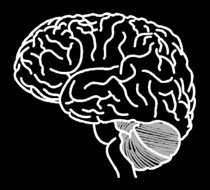


Figure 14). Through mechanisms that remain
because children with the disorder may not recog-
unknown, the brain interprets the electrochemical
nize the subtle differences between sounds in
information it receives, thus allowing us to per-
words. For example, children with APD may hear
ceive sounds as having varying loudness and
the sentence “Tell me how a couch and a chair are
pitch.
alike” as “Tell me how a cow and a hair are alike.”
What causes this apparent deficiency or slowing
in the brain’s ability to process auditory informa-
tion? Researchers do not know. Auditory process-
ing is a learned function, and if something
interferes with the brain’s training, the result may
be a deficit in the capacity to process sound.
Sound direction is localized by virtue of
our having two ears and our ability to
use different parts of the auditory system
to process distinct aspects of incoming
directional information.
Sound direction is localized by virtue of our hav-
ing two ears and our ability to use different parts
of the auditory system to process distinct aspects
Figure 14. The location of the auditory cortex in of incoming directional information. Certain cells
the human brain.
in the brainstem compare the intensities of sound
coming into each ear and then relay a computed
The brain recognizes and interprets sound in our
signal to the auditory cortex to estimate the
environment through a sequence of events called
sound’s direction. Another group of brainstem
auditory processing. A disorder, known as audi-
cells contributes to the interpretation of sound
tory processing disorder (APD), came to promi-
direction by specifically comparing the time lag
nence in the 1970s.3, 9 In APD, something
between the sound reaching them from the right
interferes with the brain’s ability to process or
ear versus the left ear.
interpret information about sound, although hear-
Nerve fibers coming from the brain may carry
ing seems to be normal. Children with APD typi-
information back to the ear. This is the brain’s way
cally have normal hearing and intelligence.
of filtering out signals that are unimportant, and
Symptoms of APD are having difficulty paying
concentrating only on important signals. Other
attention and remembering information presented
nerve fibers proceed from the brain to the middle
orally; poor listening skills; difficulty carrying out
ear, where they control muscles that help protect
multistep directions; poor spelling, vocabulary,
against the effects of dangerously loud sounds.
and reading comprehension skills; difficulty pro-
cessing information; low academic performance;
Not only does the inner ear process the sound
behavioral problems; language difficulty (tendency
vibrations it receives, it also creates its own sound
to confuse syllable sequences); and difficulty
vibrations. When hair cells respond to vibration,
developing vocabulary and understanding lan-
their movement in the fluid environment of the
guage. APD is sometimes called “word-deafness”
cochlear duct produces friction, and this results in
37
Information about Hearing, Communication, and Understanding How Your Brain Understands What Your Ear Hears
a loss of energy. However, a group of hair cells
your eardrum. A common cause of conductive
replaces the lost sound energy by creating their
hearing loss in children is ear infections. Other
own. Some of this sound energy leaks back out of
causes of conductive hearing loss are a punctured
the ear and can be detected using a computer-
eardrum or otosclerosis (a buildup of spongy tis-
based sound analyzer and a probe inserted into
sue around the middle ear). These can be treated
the outer third of the ear canal. This ability of hair
through surgery.
cells to respond to sound by producing their own
Sensorineural hearing loss is generally associated
sound is the basis of one type of hearing test per-
with damage to the hair cells in the inner ear. Such
formed on infants and young children.
damage is the most common cause of hearing loss
and can result from a number of factors working
4 Hearing Loss
alone or in combination.
The auditory pathway is capable of providing a
lifetime of useful service. It is, however, fragile
4.1 Noise exposure
and subject to damage from a variety of sources.
When hair cells are damaged, their ability to par-
Hearing loss and deafness can result from sound
ticipate in sound transduction is compromised. If
your hair cells are completely destroyed, you will
exposure, heredity, ototoxic drugs (chemicals that
be unable to hear any sounds, no matter how loud
damage auditory tissues), accidents, and disease
they are. If the hair cells are damaged, you may
or infection. Conductive hearing loss results from still hear sounds, but the sounds will be distorted.
damage to the outer or middle ear, and sen-
Recall that different hair cells respond to different
sorineural hearing loss results from damage to
pitches. The pattern of hair-cell damage deter-
the inner ear.
mines which pitches are preferentially lost. Typi-
cally, hair cells that respond to higher pitches are
Hearing loss and deafness can
lost first. One reason is that the basilar membrane
result from sound exposure, heredity,
vibrates more vigorously in response to higher
ototoxic drugs, accidents, and
pitches. These vibrations can cause the delicate
disease or infection.
stereocilia of the hair cells to be sheared off (see
Figure 15). One consequence of this damage is
that it becomes more difficult to understand the
Damage associated with conductive hearing loss
higher-pitched voices of women and children. It
interferes with the efficient transfer of sound to
also becomes more difficult to distinguish a per-
the inner ear. Conductive hearing loss is charac-
son’s speaking voice from background noise. The
terized by a loss in sound intensity. Voices may
effects of noise-induced hearing loss may be tem-
sound muffled, while at the same time the indi-
porary or permanent, depending on the intensity
vidual’s own voice may seem quite loud. It can be
and duration of the exposure. Although a person’s
caused by anything that interferes with the vibra-
hearing may recover from temporary, slight dam-
tion of the eardrum or with the movement of the
age to the hair cells, the complete loss of hair cells
bones of the middle ear. Even a buildup of earwax
is irreversible in humans. Reptiles and birds are
can lead to conductive hearing loss.
able to regenerate hair cells, however, so scientists
A number of treatment options exist for conduc-
are currently exploring ways to encourage regen-
tive hearing loss. The appropriate response
eration of hair cells in humans.
depends upon the cause of the problem. For
example, an ear doctor can simply remove a
The effects of noise-induced hearing
buildup of earwax. It should be pointed out, how-
loss may be temporary or permanent,
ever, that you should never try to remove wax
depending on the intensity and
from your own ears. You can too easily push the
duration of the exposure.
wax further into the ear canal and even damage
38
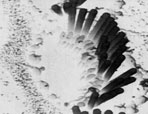
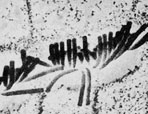
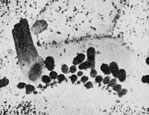
Figure 15. The left panel shows normal stereocilia (or hair bundles) associated with inner hair cells in the cochlea. The middle and right panels show noise-induced damage to hair cells. Note the bent-over stereocilia in the middle panel. The right panel shows missing and fused stereocilia.
The phrase “too loud, too long, too close” (see the
4.3 Ototoxic drugs
WISE EARS! Web site, http://www.nidcd.nih.gov/
Medications and chemicals that are poisonous to
health/wise/index.asp) summarizes the causes of
auditory structures are called ototoxic. Certain
noise-induced hearing loss. The intensity, dura-
antibiotics can selectively destroy hair cells,
tion, and proximity of sound to the listener deter-
enabling scientists to better understand hair-cell
mine whether or not damage occurs and if that
function in normal and abnormal hearing. Other
damage is reversible or permanent. Hearing loss
types of drugs can be used to selectively destroy
can result from a single loud noise, such as an
other tissues of the auditory pathway. A few com-
explosion, but more commonly results from
mon medications can produce the unwanted side
repeated exposure to less intense sounds that are
effect of tinnitus, or ringing in the ears. One such close by.
drug is aspirin. Arthritis sufferers, who may con-
sume large amounts of aspirin, sometimes experi-
ence tinnitus and hearing loss as a side effect of
The phrase “too loud, too long, too
their aspirin use. Fortunately, the effect is tempo-
close” summarizes the causes of noise-
rary and the tinnitus tends to disappear when
induced hearing loss.
aspirin use is discontinued.
4.4 Disease and infections
4.2 Aging
A variety of diseases and infections can lead to
Damage to hair cells is associated with aging,
hearing loss. Children are especially prone to the
though it is not inevitable. Such damage can result
ear infection called otitis media from viruses or
from a combination of factors, such as noise expo-
bacteria. Children are more susceptible to infection
sure, injury, heredity, illness, and circulation prob-
lems. Some of these factors, such as noise
than adults are, partly because the location of their
exposure, can take many years before their damag-
eustachian tube in relation to the middle ear allows
ing effects are noticeable. Hearing loss often begins
easier access to bacteria from the nasal passages.
when a person is in his or her 20s, though it may
These infections cause pain and may result in a
not be noticed until the person is in his or her 50s.
buildup of fluid, which can lead to hearing loss.
Not surprisingly, the greater the noise exposure
Usually, the bacterial infections can be controlled
over a lifetime, the greater the hearing loss.
by antibiotics. Antibiotics are ineffective against
Because the hair cells at the base of the cochlea
viruses, however. The over-prescription of antibi-
“wear out” before those at the apex, the higher
otics to treat viral forms of otitis media has led to a
pitches are lost first, followed by the lower ones.
rise in bacteria that are resistant to antibiotics. If
39
Information about Hearing, Communication, and Understanding How Your Brain Understands What Your Ear Hears
allowed to progress untreated, ear infections can
cation of hearing-related genes has moved at an
lead to a much more serious condition called
incredibly fast pace in the past decade. The first
meningitis. Young children who experience ear
genetic mutation affecting hearing was isolated in
infections accompanied by hearing loss for pro-
1993; by the end of 2000, the number of identified
longed periods also may exhibit delayed speech
auditory genes was over 60. Scientists have also
development. The reason for this is that the first
pinpointed over 100 chromosomal regions
three years of life are a critical period for acquiring
believed to harbor genes affecting the hearing
language, which depends upon a child’s ability to
pathway.
hear spoken words.
An important technology for investigating the
roles that genes play in hearing is the production
Young children who experience ear
of transgenic and “knockout” mice, which result
infections accompanied by hearing loss
when scientists insert a foreign gene into (trans-
for prolonged periods also may exhibit
genic) or delete a targeted gene from (knockout)
delayed speech development.
the mouse genome. The hearing responses of
transgenic or knockout mice are compared with
Otosclerosis refers to a condition in which the
their unaltered counterparts. If differences are
bones of the middle ear are damaged by the
detected, they are presumed to be caused by the
buildup of spongy or bone-like tissue. The
specific gene that was inserted or deleted. Eventu-
impaired function of the ossicles (the malleus,
ally, scientists hope to use their understanding of
incus, and stapes) can reduce the sound reaching
the genetic basis of hearing to develop treatments
the ear by as much as 30 to 60 dB. This condition
for hereditary hearing loss and deafness.
may be treated by surgically replacing all or part of
the ossicular chain with an artificial one.
The Mouse and Human Genome Projects
Ménière’s disease affects the inner ear and
are setting the stage for identifying the
vestibular system, the system that helps us main-
genetic contributions to hearing.
tain our balance. In this disorder, the organ of
Corti becomes swollen, leading to a loss of hear-
4.6 Cochlear implants
ing that comes and goes. Other symptoms include
A cochlear implant (see Figure 16) is a hearing
tinnitus, episodes of vertigo (dizziness), and
device designed to bypass absent or damaged hair
imbalance. The disease can exist in mild or severe
cells. The cochlear implant is a small, complex,
forms. Unfortunately, the cause of the disease is
electronic device that can help provide an inter-
not well understood and effective treatments are
pretable stimulus to a person who is profoundly
lacking.
deaf or severely hard-of-hearing. The implant is
4.5 Heredity
surgically placed under the skin behind the ear,
The Mouse and Human Genome Projects are set-
and consists of four basic parts:
ting the stage for identifying the genetic contribu-
• a microphone that picks up sound from the
tions to hearing. Though deciphering the genetics
environment;
underlying any developmental pathway is com-
• a speech processor, which selects and arranges
plex, identifying genes involved in the hearing
sounds picked up by the microphone;
pathway can greatly aid our understanding of the
• a transmitter and receiver/stimulator that
hearing process. Genes associated with a number
receives signals from the speech processor and
of hereditary conditions that cause deafness, such
converts them into electric impulses; and
as Usher syndrome16 and Waardenburg syn-
• electrodes that collect the impulses from the
drome,17 already have been isolated. The identifi-
stimulator and send them to the brain.
40

policy is that when a patient receives a cochlear
implant, whatever hearing they have is destroyed.
Eventually, it was discovered that patients with
some residual hearing could benefit more from
the procedure than those with profound hearing
loss. For appropriate individuals, cochlear
implants can be extremely beneficial. Each case
must be examined individually to determine
whether the cochlear implant is the best treatment
available.
The use of cochlear implants can be controversial,
especially among some deaf people. Just as spo-
ken language helps define the culture of the hear-
ing world, sign language helps define the culture
Figure 16. Diagram of a typical cochlear-implant of the deaf community. The issues surrounding
system.
the use of speech or American Sign Language by
the deaf community illustrate the profound effects
A cochlear implant does not restore or create
of language, hearing, and communication on one’s
normal hearing. Instead, under the appropriate
sense of self.
conditions, it can give a deaf or severely hard-of-
hearing person a useful auditory understanding of
5 Prevention of Noise-Induced
the environment, including sirens and alarms. A
Hearing Loss
cochlear implant is very different from a hearing
Noise-induced hearing loss (NIHL) is a serious
aid. Whereas hearing aids amplify sound and
health problem. It occurs on the job as well as in
change the acoustical signal to match the degree
nonoccupational settings. An estimated 10 mil-
of hearing loss, cochlear implants compensate for
lion Americans have suffered irreversible hearing
damaged or nonworking parts of the inner ear by
damage due to noise exposure. Another 30 mil-
bypassing them altogether. When hearing is func-
lion Americans are exposed to dangerous levels of
tioning normally, complex processes in the inner
noise every day.10 This is especially tragic because
ear convert sound waves in the air into electrical
NIHL is completely preventable. Although the
impulses. These impulses are then sent to the
consequences may vary for people who are
brain, where a hearing person recognizes them as
exposed to identical levels of noise, some general
sound. A cochlear implant works in a similar man-
conclusions can be stated. For example, studies
ner: it electronically transforms sounds and then
have shown that sound levels of less than 75 dB
sends them to the brain. Hearing through an
are unlikely to cause permanent hearing loss, even
implant sounds different from normal hearing, but
after prolonged exposure. However, sound levels
it allows many people with severe hearing prob-
equal to or greater than 85 dB—about the same
lems to participate fully in oral communication.
level as loud speech—for eight hours per day will
produce permanent hearing loss after many years.
Outcomes for patients with cochlear implants
At this time, it is not possible to predict a given
vary. For many, the implant provides sound cues
individual’s degree of sensitivity to dangerous
that help them better understand speech. Many
noise. Some people may be more sensitive to noise
are helped to such an extent that they can carry on
exposures than others.
a telephone conversation. Originally, only patients
with profound hearing loss were deemed suitable
In the work environment, employers are obligated
for the procedure. One reason for this restrictive
to protect their workers from hazardous noise.
41
Information about Hearing, Communication, and Understanding
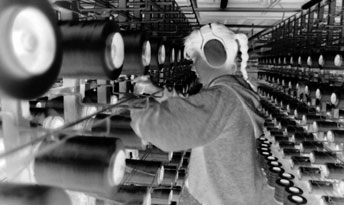
How Your Brain Understands What Your Ear Hears
Hearing-conservation programs, when imple-
become active. People experiencing tinnitus show
mented effectively, are associated with increased
brain activation in only one side of the brain,
worker productivity and decreased absenteeism.
however. This difference in neural activity caused
They also lead to fewer workplace injuries and
by external sounds (bilateral activation) versus
workman’s compensation claims. Whenever haz-
tinnitus (unilateral activation) indicates that the
ardous levels of sound are encountered, either on
disorder is likely to be a result of changes in the
the job or at home, you can protect yourself by
brain itself. Tinnitus may be produced by distur-
using ear protection such as earplugs or special
bances in auditory processing by the brain.
earmuffs. Do not simply put your fingers in your
Over 50 million Americans experience tinnitus at
ears or stuff cotton in them. Additionally, anyone
some point in their lives. The disorder is perceived
exposed to significant levels of noise for long
by some as an annoying background noise while
durations should receive regular hearing tests to
others are incapacitated by loud noise that dis-
detect changes in hearing.
turbs them day and night. Although the exact
causes of tinnitus are not known, scientists agree
An estimated 10 million Americans
that it is associated with damage to the ear. Possi-
have suffered irreversible hearing
ble triggers of tinnitus include NIHL, too much
damage due to noise exposure.
alcohol or caffeine, stress, inadequate circulation,
allergies, medications, and disease. Of these fac-
Tinnitus is the medical term for the perception of
tors, exposure to loud noise is by far the most
sound when no external sound is present. The
probable cause of tinnitus. Perhaps not surpris-
disorder is characterized by ringing, roaring, or
ingly, there is no single effective treatment.
repeated soft clicks in the ears. It is known that











